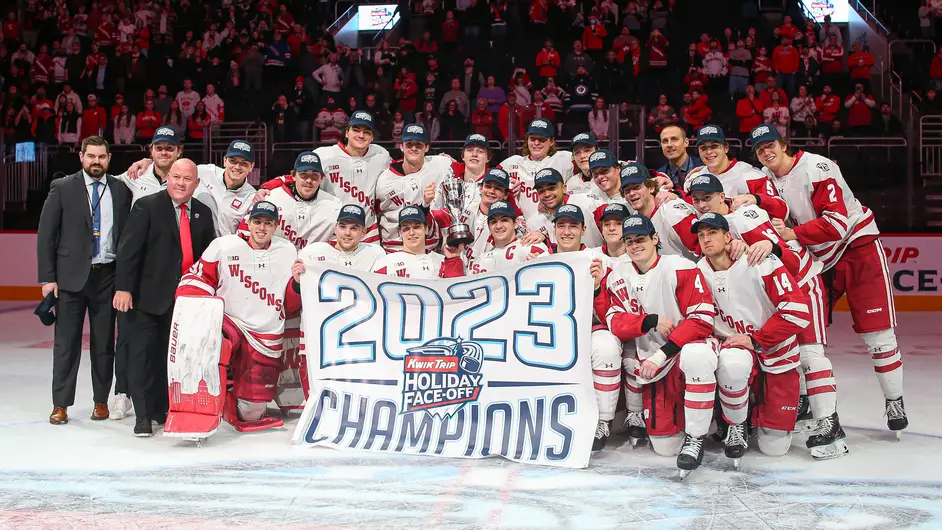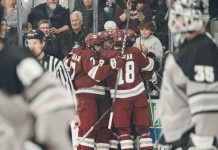
Each week during the season, we look at the big events and big games around Division I men’s college hockey in Tuesday Morning Quarterback.
Paula: Happy New Year, Jimmy!
Every year when we reach the midway point of the season, I’m always surprised both by how quickly the first half went and by how the second half of the season intensifies exponentially right at the start of the new year.
One lovely surprise this week is how much hockey was played last week. As you noted in the Monday 10, the midseason tournaments seem to be rebounding a bit and a couple of stalwarts were especially entertaining – and especially telling.
No. 8 Maine cruised to the Ledyard Classic with a 5-2 win over No. 18 RIT and 5-1 win over host Dartmouth. After beating Clarkson 5-2, No. 13 Arizona State took the Adirondack Winter Invitational with a shootout victory over No. 17 Cornell following a 2-2 tie.
Kyle McClellan shut down Air Force and Northeastern as No. 6 Wisconsin picked up a pair of 3-0 wins and the Kwik Trip Holiday Face-Off title.
In the Great Lakes Invitational, the hosting Michigan Tech Huskies came from behind twice to capture their 12th tournament title, beating Alaska 3-2 in overtime before tying No. 7 Michigan State and prevailing in that game’s shootout for the crown.
When Michigan was participating in and often dominating that tourney, Red Berenson was fond of saying that the GLI propelled its winning team to a solid second half. I’m sure that earning hardware to kick off the second half of a season gives a team confidence, but even more so this year it looks as though the teams that were performing in the first half of the season took care of business in midseason tournament play. The PairWise seems to reflect that, too.
How much do these holiday tournaments matter to teams, do you think? And do you see anything from last week’s play that tells another story?
Jim: Happy New Year to you, too, Paula.
Let me first outline start by saying I am extremely pleased with the number of in-season holiday tournaments this season. The four this weekend, along with the Turkey Leg Classic hosted by UMass Lowell and Merrimack at Thanksgiving and next week’s Desert Hockey Classic at Arizona State is a welcome return to these great events.
I miss the days when Minnesota, Denver and for a while even Robert Morris would host great holiday time tournaments. For one, I believe they break up the monotony of the college hockey season. But as one coach once told me, these tournaments also mimic league tournament and NCAA tournament weekends. Not only is it win and advance, but you play different game times which changes the routines of players, and that’s a good thing.
And of course, there is a tournament championship and trophy on the line. That’s even better. I wish there was a better solution than deciding titles in shootouts, but I’ll leave that topic for another day.
As for the results this weekend, Maine and Wisconsin both impressed me. The Black Bears seemed surgical, finding opportunities against both RIT and Dartmouth to score goals and pop 10 over two games to take the title at the Ledyard Bank.
The Badgers look like they are flowing into the trend of a typical Mike Hastings system. Limit opponent chances and have a goalie who will make the stops. Two shutouts to win a tournament makes the MVP selection a lot easier.
I mentioned Maine, which moved into the top spot of the PairWise with the two wins this weekend. This is a team picked ninth in the Hockey East preseason poll. Wisconsin impressed me, certainly. But is Maine the top story of the first half?
Paula: Given how they were perceived at the start of the season as compared to what they’ve delivered, I definitely think that the Black Bears are the top story of the first half of the season. You and I have been around college hockey long enough, too, to remember the program that Shawn Walsh built and how it perennially contended. Tim Whitehead was capable and had some success as well, but it feels like Maine has been looking for its identity for an awfully long time.
Look at what Ben Barr has done in just three seasons. The Black Bears finished last in Hockey east in Barr’s first year with five conference wins. With nine HEA wins last year, Maine tied Providence for seventh. The Black Bears finished the first half of the season with five conference wins – two fewer than league-leading Boston University and one win less than Boston College, and the Black Bears are seven points out of first place in the Hockey East standings.
And that offense! Averaging 3.57 goals per game in overall play and 10th in the nation, Maine has scored five or more goals in six games this season while being held to a single goal once. Two of the five games in which they’ve been held to two or fewer goals were against the two teams at the top of the HEA standings – a 2-2 tie to Boston University and a 3-2 loss to Boston College, both games in mid-November. The Black Bears split that series with BC, too, and they haven’t been shut out this season, either.
Then there’s the magic of the Brothers Nadeau. I’m still marveling at their back-to-back hat tricks a month ago, Josh’s against New Hampshire Dec. 1 and Bradley’s the same weekend two days later against Connecticut – with each brother recording the first assist on the other’s goals. Josh is third nationally in points per game (1.57) and Bradley sixth (1.50).
With their victories in the Ledyard Classic, the Black Bears have extended their win streak to six games. It isn’t only offense driving Maine at midseason. Senior Victor Ostman has been great lately, in net for five of the wins in Maine’s current streak and a .940 save percentage in that stretch.
I see Maine’s success as part of the bigger picture of a reemergent Hockey East, Jimmy. Some of the most exciting conference play in the past two seasons has come from Hockey East, and this season promises more of that.
There was a stretch of time in the 2000s when Hockey East seemed dominant on the national scene – or maybe it was just Boston College that was. Are we seeing Hockey East assert itself as a conference with more than just a top two or three teams capable of making noise nationally every year?
Jim: As what many consider a Hockey East homer, I actually approach that topic carefully. Right now, Maine, BC and BU are dominant nationally. All three will be in the top half of the NCAA bracket come March.
But other teams that are among the PairWise positive teams still concern me. Can Providence remain consistent? Is UMass as good as its record? And should UNH be considered a top-tier team yet?
Personally, I think all three are pretty greasy – admittedly through league-colored glasses. My real opinion, though, is come March four teams will make the NCAA field. Six would be nice but a massive stretch.
As for the league I see upside from, believe it or not, it isn’t the Big Ten. I think the NCHC has tons of potential and easily might get four of its eight teams into the NCAA field.
Is that a stretch in your eyes?
Paula: Not a stretch at all. I definitely see the potential of the NCHC to place half of its teams in the tournament. If the Big Ten has more than three teams in the tournament, I’d be surprised – and I worry about only three B1G teams making it.
The NCHC has been, since its inception, a threat every year. The top four teams in that conference right now – St. Cloud, North Dakota, Western, Denver – are each capable of a national championship run, and three of the bottom four teams in the conference may be capable of taking a regular-season championship and the autobid for the conference.
What the conference has done is impressive, and even when it looks “down” as a whole, there is always at least one program that’s undeniably in the national championship mix.
For the last few years that’s been Denver with David Carle on the bench as either head coach or assistant. It’s impossible to ignore Carle’s impact on college hockey as a whole, as any coach as dominant as Carle elevates the level of play of teams in his conference.
And look what he’s doing with Team USA in the World Juniors this tournament. Two games with 10 or more goals, a solid 4-1 win over Norway to begin the tourney and a 4-3 shootout win over Czechia when starting goaltender Trey Augustine was out with an illness.
Speaking of Hockey East and the Big Ten, those are the conferences most represented on the Team USA roster. One thing that I watch in the World Juniors every year is to see which conferences are most represented and how those players are doing. It’s a barometer for who’s attracting U.S.-born talent – and it’s been a good predictor of success for those players.
It appears to me that the conference I cover, the Big Ten, is a mighty fine place for talent to develop. For reasons I can’t quite put my finger on, though, that hasn’t translated into success on the national level in the NCAA.
Jim: Well, the one thing I have learned about World Junior representation versus end-of-season success is that there isn’t – and maybe shouldn’t be – a correlation.
The World Juniors is still a young person’s tournament while we have learned the Frozen Four is more about the older talent in a lineup. Yes, every now and again you will find a team where a young freshman can dominate, but I can’t remember the last time a team where six or more underclassmen were among the team’s leader scorers that went on to win a national title.
There is no better global event than World Juniors and I always root for Team USA. But the players who often bring home gold in that event rarely also raise an NCAA trophy come April.


